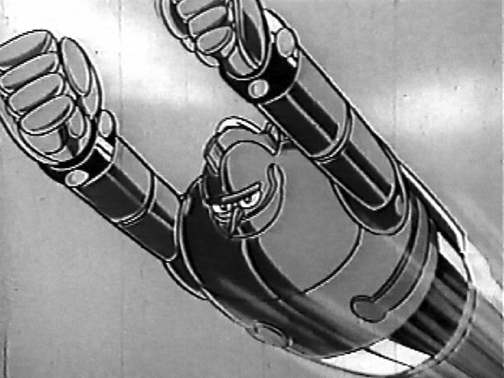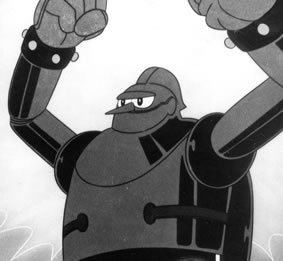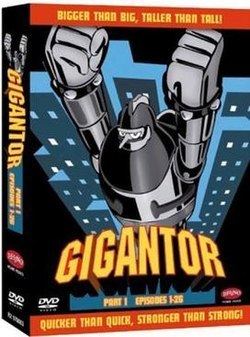7.2 /10 1 Votes
7.2/10 TV Original network Fuji Television First episode date 20 October 1963 | 7.3/10 IMDb No. of episodes 52 First shown in Japan Network Fuji Television | |||||||||||||||||||||||||||||||||
 | ||||||||||||||||||||||||||||||||||
Created by Mitsuteru YokoyamaFred Ladd Voices of English dub:Billie Lou WattCliff OwensGilbert MackPeter Fernandez Cast Kōsei Tomita, Kazue Takahashi, Minoru Yada, Fuyumi Shiraishi, Yuzuru Fujimoto | ||||||||||||||||||||||||||||||||||
Gigantor is an American adaptation of the anime version of Tetsujin 28-go, a manga by Mitsuteru Yokoyama released in 1956. It debuted on U.S. television in 1964. As with Speed Racer, the characters' original names were altered and the original series' violence was toned down for American viewers. A new series was produced in Japan in 1980 and was later shown as The New Adventures of Gigantor, on the Sci Fi Channel from 1993 to 1997.
Contents

Plot

The series is set in the year 2000. The show follows the exploits of Little Jimmy Sparks, a 12-year-old boy who controls Gigantor, a huge flying robot, with a remote control. The robot is made of steel and has a rocket-powered backpack for flight, a pointy nose, eyes that never move, and incredible strength, but no intelligence (although he started to tap his head as if trying to think in one episode). Whoever has the remote control controls Gigantor.

Originally developed as a weapon by Jimmy's father, Gigantor was later reprogrammed to act as a guardian of peace. Jimmy Sparks lives with his uncle Dr. Bob Brilliant on a remote island. Jimmy usually wears shorts and a jacket, carries a firearm and occasionally drives a car. Together, Jimmy and Gigantor battle crime around the world and clash with the many villains who are always trying to steal or undermine the giant robot.
History

In 1963, Fred Ladd, while working on the animated feature Pinocchio in Outer Space and on the animated TV series The Big World of Little Adam had seen artwork of Mitsuteru Yokoyama presenting a giant robot remote-controlled by a young boy. The Tokyo-based artist had designed the robot for a Japanese shōnen manga series Tetsujin 28 and later a black-and-white animated TV series called Tetsujin 28-go.
Ladd, who had produced the successful international, English-language adaptation of Astroboy, and Al Singer formed a corporation called Delphi Associates, Inc. in order to produce and distribute an English-language version of Tetsujin 28-gō. They took only 52 episodes of the Japanese series for the American market, and renamed the series Gigantor. Peter Fernandez wrote much of the English script, and participated in the dubbing. The series became an immediate hit with juvenile audiences, though adult reactions were sometimes hostile.
It was playing at 7:00 p.m. on New York's WPIX-TV in January 1966 when Variety gave it a particularly scathing review, calling it a "loud, violent, tasteless and cheerless cartoon" which was "strictly in the retarded babysitter class".
The reviewer added that Gigantor was popular; he said "Ratings so far are reportedly good, but strictly pity the tikes and their misguided folks."
Gigantor became a popular Japanese export during this time. The series was shown in Australia on Melbourne television in January 1968 through Trans-Lux, on ATV-0 at 5:00pm. It was described by the TV Week as an "animated science fiction series about the world's mightiest robot, and 12-year-old Jimmy Sparks who controls the jet-propelled giant". The series aired in other markets around Australia, including Sydney, New South Wales on TEN-10, and in Adelaide, South Australia on SAS-10, (its debut on Monday October 28, 1968 at 5.55pm). It was also screened in New Zealand around the same time.
Gigantor was one of a number of Japanese TV series that enjoyed strong popularity with young viewers in Australia during the 1960s. The first and undoubtedly the most successful of these was the hugely successful live-action historical adventure series The Samurai, the first Japanese TV series ever screened in Australia, which premiered in late 1964. It was followed by a contemporary ninja-based live action espionage series, Phantom Agents, and a number of popular Japanese animated series including Astro Boy, Ken The Wolf Boy, Prince Planet, and Marine Boy.
In July 1994, Fox Family Films, a division of 20th Century Fox, acquired the rights to "Gigantor" for a live-action motion picture. Anticipating that Gigantor would become a franchise for the studio, Fox tapped screenwriters Steve Meerson and Peter Krikes to prepare the script and budgeted between $35 million and $50 million for the film. Executive producers Fred Ladd and Aeiji Katayama indicated that Mitsuteru Yokoyama would get an executive producer credit and that the 50-foot robot would be updated and modernized for the 1990s with a 12-foot height and morphed and computer-generated features. However, the project has yet to come to fruition and Mitsuteru Yokoyama has since died.
Characters
Whimsical English names were given to the show's characters, such as "Dick Strong", a secret agent; a funny policeman named "Inspector Blooper"; and enemies, such as, "The Spider", "Dubble Trubble", and "Dr. Katzmeow". Other characters included Bob Brilliant's teenage son, Button, as well as his housekeeper, Lotus.
Jimmy Spark's voice was that of Billie Lou Watt. The voice of Inspector Blooper was that of Ray Owens. Old time radio listeners might find the Inspector Blooper sounds a lot like the Willard Waterman/Harold Peary-voiced character "The Great Gildersleeve." Gilbert Mack voiced Dick Strong. Peter Fernandez provided the voices of other Gigantor characters.
Sequels and spin-offs
The 1980–81 New Iron Man #28 (Shin Tetsujin-nijuhachi-go) series was created with 51 episodes based on a modernized take upon the original concept art. In 1993, Ladd and the TMS animation studio converted the series into The New Adventures of Gigantor and broadcast it on America's Sci-Fi Channel from September 9, 1993 to June 30, 1997.
During this time it must be noted that the series was shown on Spanish Television under the name "Iron-Man 28.
There was also a sequel series, Tetsujin 28 fx (Tetsujin-nijuhachi-go-Efu-Ekkusu), about the son of the original controller operating a new robot (with Daddy and the original FX-less #28 appearing from time-to-time to help), which ran in Japan in 1992.
In 2004, a new Tetsujin 28-go series was made which returned to the original story established by the manga and original anime series. This version was released in the United States on DVD under the original Japanese title of Tetsujin 28. Unlike Gigantor however, the English translation of this series is closer to the original Japanese version, with all Japanese names retained.
A number of characters and robots from the Tetsujin 28 series appeared (albeit with altered backgrounds) in Giant Robo: The Animation, an OAV series that drew on Mitsuteru Yokoyama's entire body of work. In one of the Giant Robo parodic spin-off OAVs, "Mighty GinRei" (Tetsuwan GinRei), a version of the original Tetsujin appears under the name "Jintetsu".
A comic version of Gigantor ran in the Triple Action anthology series from Eternity Comics from issues #1–4.
An American made Gigantor comic book series was released in 2000 by Antarctic Press. The comic lasted for twelve issues and was later collected in 2005 in trade paperback form. The comic used elements from the anime Giant Robo as well as Marvel Comics references though the later issues became closer to the original animation.
Creators behind Gigantor have unveiled plans for another updated design, a "Gigantor for the New Millennium." This newest form of the giant robot is called G3 and differs from past designs. The new Gigantor is a meld of robot and cyborg. According to the main site: "Driven by a complex neuro-system of DNA-impregnated neurochips, Gigantor G3 is a living Cybot!".
